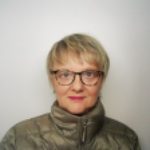Link to Pubmed [PMID] – 39178861
Link to DOI – 10.1016/j.molcel.2024.08.003
Mol Cell 2024 Sep; 84(17): 3237-3253.e6
Homology search is a central step of DNA double-strand break (DSB) repair by homologous recombination (HR). How it operates in cells remains elusive. We developed a Hi-C-based methodology to map single-stranded DNA (ssDNA) contacts genome-wide in S. cerevisiae, which revealed two main homology search phases. Initial search conducted by short Rad51-ssDNA nucleoprotein filaments (NPFs) is confined in cis by cohesin-mediated chromatin loop folding. Progressive growth of stiff NPFs enables exploration of distant genomic sites. Long-range resection drives this transition from local to genome-wide search by increasing the probability of assembling extensive NPFs. DSB end-tethering promotes coordinated search by opposite NPFs. Finally, an autonomous genetic element on chromosome III engages the NPF, which stimulates homology search in its vicinity. This work reveals the mechanism of the progressive expansion of homology search that is orchestrated by chromatin organizers, long-range resection, end-tethering, and specialized genetic elements and that exploits the stiff NPF structure conferred by Rad51 oligomerization.

